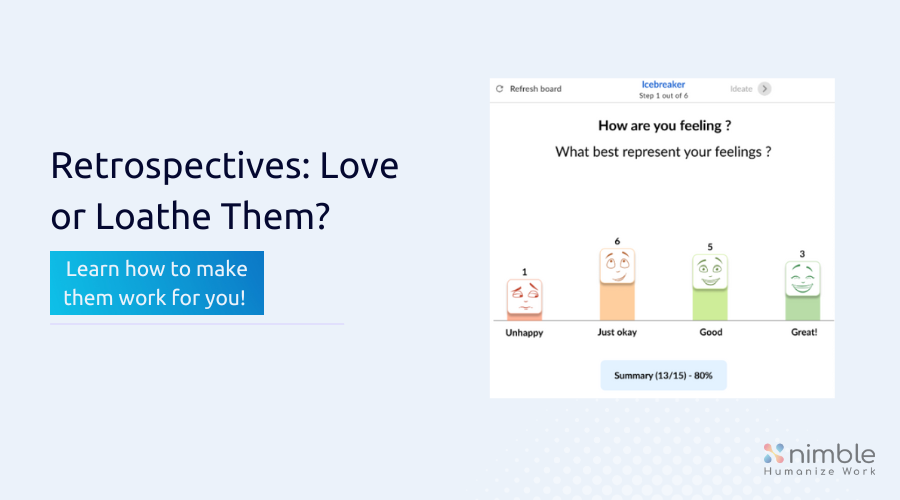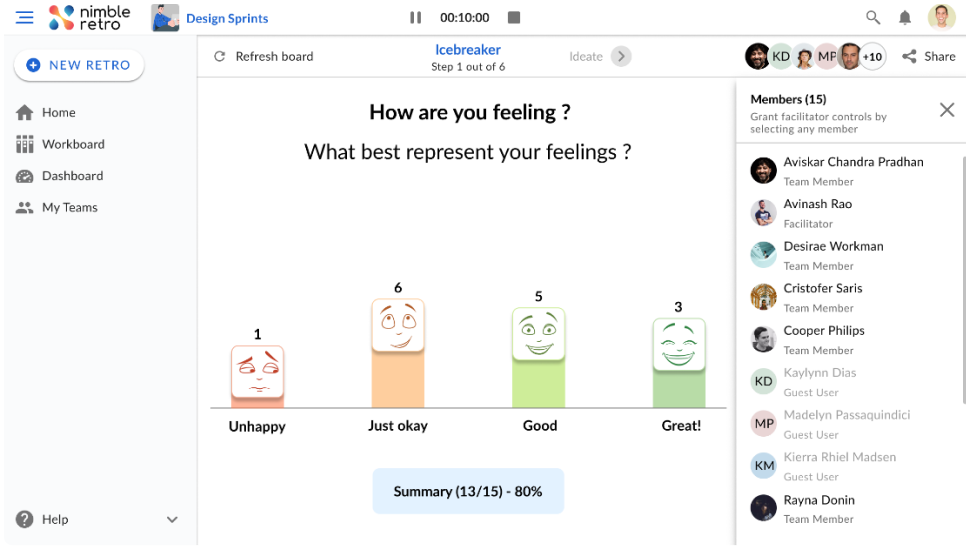Navigate to
Retrospectives: Love Or Loathe Them? Make Them Work For You!
- 9 mins read
- By Carlos Schults

Retrospectives — or “retros” for short — are one of the most well-known components of agile methodologies.
But not everyone is a fan.
While many praise their virtues, others loathe the concept, considering it a waste of time.
You’ve heard arguments from both sides.
But who’s right?
Let’s find out by first covering the fundamentals — what is a retro and why should you care? — and then working through the arguments of both views and analyzing which hold up.
After that, you’ll also find practical tips to
1. counter the downsides of retros, real or perceived, and
2. make sure your retros are effective and generate value for your team.
Let’s dig in.
Agile Retrospectives: The Fundamentals
As promised, let’s start by walking you through the basics of retros.
What Are Retrospectives?
Retrospectives are meetings in which an agile team looks back and reflects on what went well and what didn’t, with the aim to continue (and improve) the former and work out strategies and tactics to mitigate the latter.
As such, retros are a crucial part of continuous improvement in an empiricist approach.
Teams usually conduct a retro once in every work cycle — for example, once per Sprint when you’re following Scrum.
Typically, you’d have a retro at the end of a cycle so that your team members can share their wins and struggles, uncover opportunities for improvements in their processes and communication, and use all that going forward. Like when you’re planning your next work cycle.
Scrum and retrospectives may sound synonymous, but retros are widely used outside of it.
For example, in other agile methodologies. Like Kanban, where teams use retros to review their work and identify improvement opportunities for their process flow, work items, or tools.
Non-agile approaches also use retrospectives, though they may not be called that and may not happen regularly unless the approach is based on a PDCA cycle. Post mortem, project wrap-up, and debrief are other terms often used in these contexts.
Why Are Retrospectives Important?
Reflection — taking a pause to analyze your work and correct your course – is part and parcel of agile.
“At regular intervals, the team reflects on how to become more effective, then tunes and adjusts its behavior accordingly.”
— Agile Manifesto (the principles)
For instance, the daily standup is a …well, daily … moment of reflection during which team members can share their learnings, ask for (and offer) help, and ensure everyone is on the same page.
These daily meetings typically are about work progress and any immediate risks to that.
While important, they’re not enough for a team to continue running smoothly and effectively.
Retrospectives allow team members to take a step back from the daily issues, to come up for air, and look at their work in a much broader sense.
Everything that affects their work is fair game in a retro: practices, tools, standards, collaboration, communication, etc.
Without this type of regular reflection, you risk running on autopilot.
This means you miss out on ditching what was a good idea at the time but is no longer effective and on adopting and amplifying what can make doing your job more effective, efficient, and enjoyable.
A Case for Why Retros Are a Waste of Time
If retrospectives are so useful, why are so many people dead set against them?
What are the arguments they use?
• Retros are repetitive and tedious. People complain that retrospectives tend to become quite same-y and repetitive after a while, as the same points keep being brought on.
• They take time away from “real” work. Another common criticism is that retrospectives take the time that teams could use to deliver customer value.
• Discovered issues aren’t acted upon. Critics often say that the items people bring up during retros aren’t acted upon, making the whole process useless.
• Retros make team members uncomfortable. Introverted people might feel shy or uncomfortable, especially if they feel they “have” to share during the retros and the process isn’t anonymous.
• Retros create unnecessary drama. Something else you hear a lot is that retros often degenerate into a toxic, finger-pointing, blame-assigning exercise.
• They don’t allow enough change. Finally, some critics state that using retros means that teams can only reflect on change and suggest actions once an iteration.
While some of these hold at least some water, others are based on wrong assumptions or blame the effects of how they’re conducted on retros as a concept.
I’ll get back to these arguments later.
But first, let’s look at a related question.
Are Retros, Even Bad Ones, Better Than Nothing?
Is a bad retrospective better than no retro at all?
TL;DR: “yes”.
Want to know why?
If you believe that retros are useless and impossible to fix, then of course, it’s better not to have them.
Believing that is saying that learning from the past is futile.
And then: l’histoire se répète — history repeats itself. You stay stuck.
If you’re interested in improving how you go about work, individually and as a team, bad retrospectives aren’t a hopeless case.
You see, when you’re new at something, by definition, you’re not going to be very good at it.
The good news?
If you suck at something but are willing to practice, experiment, and reflect, the only way is up.
Which is exactly what retrospectives are for. Even if the retros themselves (still) suck.
• Bad retrospectives, while not perfect, do offer opportunities for reflection — which, remember, is a crucial part of agile and continuous improvement.
• Retros, even faulty ones, offer team members the opportunity to hone their communication skills. And guess what: communication is both super important and incredibly hard, so you want to treat any chance people get to practice as a gift.
• Retrospectives foster connection. A problem shared is a problem halved, even if there is no immediate change. As long as you stay away from blame, ridicule, and other toxic responses, sharing wins and struggles builds connection. And connecting in a meaningful way is the first step towards growing the trust you need to get teams to collaborate so they can be creative and innovative.
• Nothing stops you from running a retro on your retros. Dedicate a retro to improving the way you conduct them. Get people to think about what would help them get more out of each. Change the rules. Make them work for you.
Keep in mind that, as you’ve seen, reflection is an essential part of agile and continuous improvement.
So, even if you don’t do retrospectives per se, do something that enables your team to reflect on the work they’ve done and adapt as necessary.
A Case for Why Retros Are Crucial
Now, let’s see the other side of the story, covering some arguments for why retrospectives are essential:
• Retros offer a reflection opportunity at a nice cadence. Having established the importance of reflection, it suffices to say the retros give teams reflection at nice, regular intervals.
• They help teams celebrate and give recognition. While it’s essential to deal with problems, it’s equally valuable to celebrate work well done and give our peers recognition for their efforts. Nothing motivates like a little acknowledgment.
• Retrospectives widen perspectives. In your day-to-day work, it’s easy to lose sight of the larger picture. Retros help you reconnect with the purpose and needs of your team.
• Retros are spotlights. During an iteration, you’ll encounter issues. By the end of the iteration, they’re often dealt with and forgotten. If instead, you keep track of them for discussion in a retro, you give yourself a unique opportunity to investigate whether there are any structural problems to address.
• They are classrooms. They allow you to highlight highs and lows and ensure that everyone on your team hears about them.
• Retrospectives offer laser-like focus. Instead of addressing issues individually, retros help you address many issues all in one fell swoop by identifying the root cause of all of them.
• Retros give you the breathing room to prioritize effectively. When you first adopt a new approach to organizing your work, agile or otherwise, you’re likely to encounter many issues. In addition to whittling them down to root causes, a retro gives you the breathing room to decide which issue to prioritize — the one that gives you the most bang for your buck when addressed.
• They foster a sense of unity in the team. An experience I often have during retros is that I share a point of view that I think is unique, only to learn that many of my peers feel the same way. I think this strongly contributes to a sense of unity and belonging inside a team.
How To Address the Alleged Downsides of Retros
Let’s turn back to the arguments cited by retrospective haters.
• They’re repetitive and tedious
It’s true retros can become same-y and mundane. But that’s not inherent to retros and is easy to avoid. Shake things up a bit. For example, rotate who facilitates the retro. And change the format regularly so it remains fresh and interesting. Address different aspects of your work and how you work together as a team.
• Take time away from “real” work
Do retros take time from real work? Of course not: retros are real work.
Don’t forget retros serve to identify and address issues that hold up work and identify and amplify what makes work more effective and efficient. Without retros, you may be losing much more time than they take! If time is still an issue, timebox the meetings.
• Issues are not acted upon
Issues brought up during dailies can indeed go unaddressed. However, that’s not necessarily a bad thing. Yes, keep track of what’s brought up during an iteration. But don’t fall into the trap of turning that into a to-do list.
Use your retro to identify the one or two most important issues to address and forget the rest. If something is still an issue after fixing these two, you can safely bet it’ll rear its head again without your help.
• They make people uncomfortable
Sure, retros can cause discomfort to some team members. All meetings can. That’s because not everyone likes to speak up or is comfortable shooting from the hip — responding in the moment.
So find ways to make it safe and conducive for all to contribute:
• Find other ways than talking to share thoughts and insights.
For example, stickies on a virtual whiteboard.
• Give people time to prepare, to gather their thoughts — not everyone thinks on their feet.
Share the retrospective’s topic in advance. Add the questions you’re looking to get answered.
• Avoid peer pressure and other influences on what and how people are willing to say and do by ensuring people can vote and share anonymously.
Yes, that means using (online) tools, like NimbleRetro, even when everyone is in the same room.
• They create drama
What about it? Is drama in the workplace so bad?
Yes, it is, but hear me out: no one learns anything from agreeing with each other. A bit of struggle and strive helps to create better, easier, more effective, [fill in what you need] solutions. That’s why a healthy dose of conflict and disagreement is a valuable thing.
If your retros are drama-ridden toxic affairs, deeper issues are usually at play than what is being fought over. It may even be a sign of a diseased organizational culture.
The key is not to try and fix the organization but to focus on your team and ensure your fellow team members treat each other respectfully. Team agreements and calling out undesirable behavior can help to avoid and reduce toxicity in a team.
• They limit taking action
The claim that retros prevent more frequent improvements is just nonsense.
No one makes you wait for a retro to improve something.
Conducting regular retrospectives ensures that if people are too caught up in the daily grind, you have a “centralized’ moment to bring up issues and suggest solutions.
Make Your Retrospectives Work for You!
If just hearing the word retrospectives makes you cringe, I can understand the sentiment. As a software engineer, I suffered through my (un)fair share of terrible retros.
But I hope I convinced you that the arguments against retrospectives aren’t inherent to the idea of reflection and learning but stem from how they’re conducted. And that I’ve armed you with the arguments to make your case for holding retrospectives when you need it.
To wrap up, here are the key tips again to rock your retros:
• Shake things up: alternate facilitator and format
• Pick your battles: track all (during an iteration) but pick only one or two issues to address
• Create safety and take measures that help everyone to contribute in a way that suits their neurological and psychological makeup.
• Foster an atmosphere that makes it okay to show vulnerability and disagree with each other.
Perhaps most important of all: make retros fun, add some levity.
And remember that for people working remotely, retrospectives offer moments of human connection.
So, make them count.
And check out NimbleRetro — it’s designed to make your retros rock.
Author:




